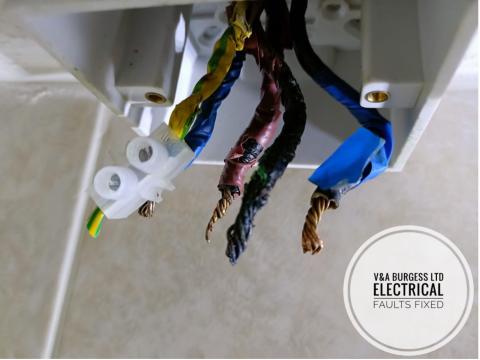
Table of Contents
1) What types of consumer unit problems are there?
There are many consumer unit problems that we come across on a regular basis. Some of these are small and can be fixed very easily and others require further work and intervention. Typical CONSUMER UNIT PROBLEMS would include things like:
- Poor wiring internally
- Poor busbar / copper power bar fitment
- Bad quality replacements or mismatched equipment
- Heat damage or signs of burning
- Old or worn components
- Messy wiring
- Holes in the consumer unit that may be dangerous
- Poorly terminated cables
2) What about poor wiring internally?
There are many consumer units that we inspect weekly where the wiring inside has been carried out so poorly that working inside the unit is nearly impossible, requires more time and costs the customer more money than necessary. This is often the case where wiring has been carried out by unqualified persons or just general poor workmanship. Poor internal wiring can lead to overheating by overcrowding, poor connections, premature failure of electrical cables or components and other problems. We can see from the pictures that wiring can be particularly messy inside some consumer units. This is not always a problem but can be when excessive cable is bunched or shoved inside.
3) Poor busbar / copper power bar fitment?
When the busbar (copper power bar underneath the circuit breakers) fits badly then there can be serious problems. This bar that runs underneath the circuit breaker is responsible for distributing the electrical current to each of the circuit breakers and meeting the power demands of your home. If the fit is poor or the terminations are not correctly torqued according to manufacturer’s instructions there can be loose connections causing overheating and fire risk. Conversely if the connections have been tightened too far, there can be stresses on the connections and metals creating other problems.
Back to top4) Bad Quality replacements or mismatched equipment
When electrical components in a consumer unit are replaced, it is important that they are replaced with the same manufacturer’s switches. This is because, most manufacturers design and build their equipment to different dimensions, specifications and tolerances. Even if the physical dimensions of the circuit breaker are the same as another it does not mean that the manufacturers have designed the internals to work in the same manner and in particular heat and electrical current dissipation. Electrical Regulation 536.4.203 requires that IF different manufacturers components are to be used in a consumer unit that they must have undergone verification by the original manufacturer to confirm their suitability.
We can see from the photograph that different equipment has been used here and this has affected the copper busbar underneath the circuit breakers, forcing it out of the neighbouring circuit breaker and putting strain on the busbar and the connections with each of the breakers.
5) Heat damage or signs of burning
Heat damage or signs of burning is a common consumer unit problem and, in many cases, could be completely avoided. Neglect of electrical systems in the domestic property is incredibly common. People simply do not question the safety of something that appears to be working fine and, in many cases, there can be hidden dangers leading to serious situations developing.
Heat damage or burning within the consumer unit is generally only picked up upon when severe damage has been done. For smoke or burning odours to leave the consumer unit enclosure the situation has normally gotten terminal in terms of the fate of the consumer unit. Once the pungent odours of electrical and PVC burning reach our nostrils it is normally too late to attempt to save the consumer unit.
There are occasions when we can replace several components and repair wiring of course and this is great, we then normally recommend a full electrical inspection to check for further loose connections around the electrical installation along with other hidden issues.
Back to top6) Old or worn components
As electrical components age, they wear. Connections become loose, internal moving parts become worn, corrosion occurs and electrical resistances increase within those components. These changes can lead to failure, arcing or in some extreme cases, fire. If you have any concerns over the age or condition of your electrical installation then it is best to book an electrical inspection so your electrician can test the circuits and consumer unit in your property and produce a report on the condition of the installation.
Back to top7) Messy Wiring
Whilst messy wiring does not necessarily constitute a danger it can cause issues where there is excessive bunching and pressure on cabling. Heat can build up and increase the risk of fire, cables can press against each other or metal surfaces and short-out along with other issues. Electrical wiring regulation 134.1.1 States that good workmanship and materials by skilled persons shall be used in the erection of wiring systems. Messy wiring can often indicate that a lack of care has been used when carrying out electrical wiring and installation work and this gives case for concern in other parts of the installation that cannot be seen.
Back to top8) Holes in the consumer unit
In general, holes in the consumer unit should be avoided. Where possible, installation of a consumer unit should happen whilst avoiding leaving unnecessary gaps. Holes in a consumer unit are not always dangerous however. There are certain holes in a consumer unit that, whilst not perfect, are acceptable and do not present any danger. We can see from the photograph of the consumer unit in this blog that there is a large hole in the front of the consumer unit. This is completely unacceptable. It is entirely possible to insert a finger and touch live parts thus inviting the risk of electrocution.
Certain holes do not present the same danger and the risk of this can only be assessed by a qualified electrician familiar with the wiring regulations. If you have holes in your consumer unit that are worrying you then please contact us for an electrical inspection. We will be able to tell you if there are dangerous situations that need attention.
Back to top9) Poorly terminated cables
We can see from the photograph that there is a cable that has been taped up inside the consumer unit. This is a special type of cable that has a steel armour preventing penetration from sharp tools and other potential damage. This cable requires a special metal connector (gland) that attaches correctly and ensures the earth is safe. The installer has simply not bothered to do that and as such, the integrity and safety of the cable has now been compromised.
During an electrical inspection we pick up on many situations like this that could easily have been avoided and are now causing problems. An electrical inspection is one of the best ways to achieve peace of mind for your biggest investment. Check out our inspection page for more information or contact us today.
Back to top









